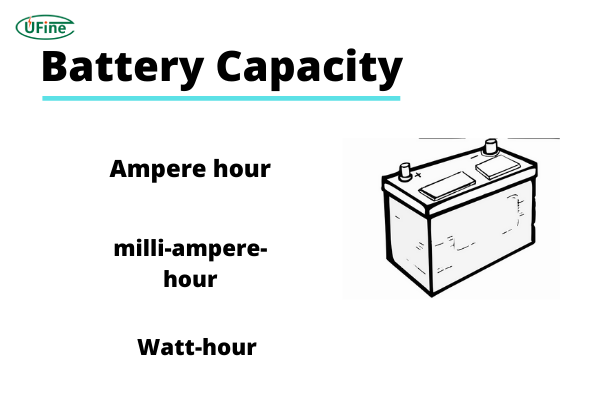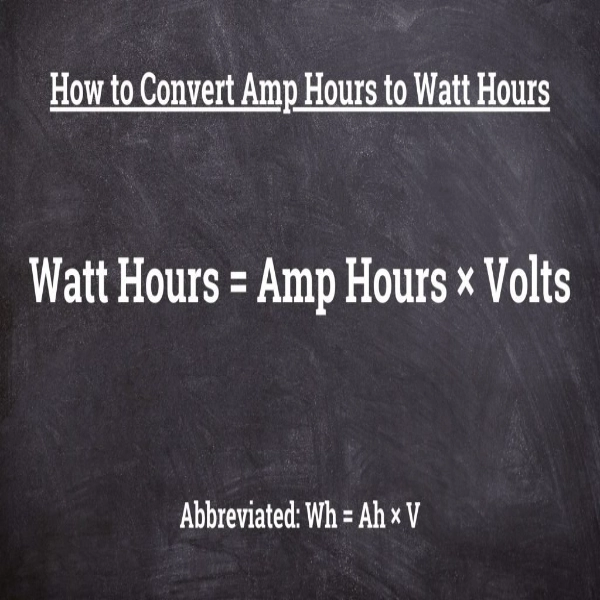The terms “amp hours” and “watt hours” are frequently encountered in batteries and energy storage. Understanding these two units’ differences is crucial for anyone with power systems. This article will demystify the concepts of amp hours and watt hours, explain their differences, provide insights into their conversion, and highlight the importance of knowing these distinctions.

Part 1. What is an amp-hour?
Let’s start by clarifying what an amp-hour (Ah) is. An amp-hour is a unit used to measure the capacity of a battery or how much electricity it can deliver over a specific period. Simply put, it represents the current a battery can continuously supply for one hour. The “amp” in amp-hour refers to the unit of electric current, while “hour” denotes the duration.
For example, suppose a battery has a capacity of 10 amp-hours. In that case, it can provide a continuous current of 10 amps for one hour. Alternatively, it could deliver five amps for two hours or even 1 amp for ten hours. The capacity of a battery is one of the essential specifications to consider when selecting the right power source for a particular application.
Part 2. What is a watt-hour?
Moving on to watt hours (Wh), this unit measures the total energy consumed or produced over a specific period. Unlike amp-hours, which focus on current capacity, watt hours consider an electrical system’s current and voltage.
In simple terms, watt hours represent the energy expended or generated over time. It’s a comprehensive measure incorporating the current’s intensity (amperage) and the electrical potential (voltage). You can determine the watt-hour rating by multiplying the voltage by the current in a given time frame.
For instance, if a device consumes 100 watts of power and operates for 5 hours, the total energy consumed is 500 watts-hours (100 watts * 5 hours = 500 watts-hours). Similarly, a solar panel that generates 200 watts of power for 3 hours will produce 600 watt-hours (200 watts * 3 hours = 600 watt-hours).
Part 3. Differences between amp hours and watt hours
- Measurement Units: Amp-hours (Ah) measure electric charge capacity, while watt hours (Wh) measure energy consumption or capacity.
- Amp Hours (Ah): This indicates the amount of electric charge a battery can deliver or store over time, typically used in batteries to quantify their capacity.
- Watt Hours (Wh): It represents the total energy consumed or stored by a device or battery, calculated by multiplying the voltage by the amp hours.
- Voltage Dependency: Amp hours remain constant regardless of voltage, while voltage changes influence watt hours due to their calculation involving voltage.
- Calculation: To calculate amp hours, divide the capacity (in Ah) by the discharge rate (in amps). In contrast, watt hours result from multiplying the voltage (in volts) by the amp hours.
- Usage in Electrical Engineering: Amp hours are primarily used in electrical engineering to measure batteries’ charge capacity, while watt-hours measure energy consumption or capacity in various electrical systems.
Part 4. How do you convert amp hours to watt-hours?

Converting amp hours to watt-hours requires considering the voltage of the system in question. To perform the conversion, you must multiply the amp-hour rating by the voltage. The formula is as follows:
Watt hours = Amp hours * Voltage
For instance, if you have a battery with a capacity of 10 amp hours and it operates at a voltage of 12 volts, the energy stored in the battery can be calculated as:
Watt hours = 10 Ah * 12 V = 120 Wh
Conversely, suppose you have a watt-hour rating and want to determine the amp-hour equivalent. In that case, you can use the following formula:
Amp hours = Watt hours / Voltage
It’s important to note that the voltage used in the calculation should remain consistent throughout the conversion to ensure accurate results.
Part 5. How do you calculate battery runtime?
Step 1: Gather the Required Information
To calculate battery runtime, you’ll need the following information:
- Battery Capacity: Identify the battery’s amp-hour (Ah) or watt-hour (Wh) rating. The manufacturer usually provides this information; you can find it on the battery’s label or documentation.
- Device Power Consumption: Determine the power consumption of the device or system you intend to power with the battery. This information may be available in the device’s specifications or user manual. If not, you can use a power meter to measure the device’s power consumption.
Step 2: Convert Battery Capacity to Watt Hours (Wh)
If the manufacturer provides the battery capacity in amp-hours (Ah), convert it to watt-hours (Wh) if necessary. To do this, multiply the amp-hour rating by the battery’s voltage. The formula is as follows:
Watt hours (Wh) = Amp-hours (Ah) * Voltage (V)
Step 3: Determine Device Power Consumption
If the device’s power consumption appears in watts (W), proceed to the next step. However, if it is specified in milliwatts (mW) or another unit, convert it to watts by dividing the value by 1000 (since 1 watt = 1000 milliwatts).
Step 4: Calculate Battery Runtime
Divide Battery Capacity by Power Consumption: Divide the battery’s capacity (in Ah) by the device’s power consumption (in watts) to obtain the runtime in hours.
Battery Runtime (hours) = Battery Capacity (Wh) / Device Power Consumption (W)
Example Calculation: For instance, if you have a 10 Ah battery and your device consumes 5 watts of power, you can calculate the runtime as follows:
Battery Runtime= 5 W/ 10 Ah=2 hours
Consider Efficiency and Battery Degradation: Adjust the calculated runtime by multiplying it by the battery’s efficiency percentage. For example, if the battery has an efficiency of 90%, multiply the calculated runtime by 0.9 to get a more realistic estimate.
Part 6. Why must you know the difference between amp and watt-hours?
Battery Selection
When choosing a battery for a specific application, such as an electric vehicle or a solar power system, knowing the amp-hour and watt-hour ratings helps ensure you select the correct battery with the appropriate capacity and energy requirements.
System Efficiency
By analyzing a system’s watt-hour consumption or production, you can assess its efficiency and identify areas for improvement. Monitoring energy usage helps optimize performance and minimize waste.
Power Management
A clear understanding of amp and watt hours enables effective power management. It allows you to estimate how long a battery can power a particular device or system and plan accordingly.
Energy Budgeting
For off-grid or renewable energy systems, knowing the watt-hour consumption helps in budgeting and determining the battery bank size or the capacity of the solar panels needed to meet the energy demands.
Troubleshooting
When troubleshooting power-related issues, differentiating between amp hours and watt hours can provide valuable insights into the root cause of the problem. It helps pinpoint whether the issue lies in the battery’s capacity or the system’s energy consumption.
Part 7. Conclusion
By grasping the dissimilarities between amp hours and watt hours, you can make informed decisions, optimize energy usage, and ensure the efficient operation of various electrical systems. So, next time you encounter these terms, you’ll have the knowledge to differentiate between them and harness their power effectively.
Related Tags:
More Articles

Overview of Deep Cycle Lithium Battery
In this article, we explore the life, voltage, capacity, and charging considerations of deep cycle lithium batteries.
How Long do Lithium Batteries Last?
How long do lithium batteries last? we will explore the factors that influence the lifespan of lithium batteries and provide insights into their longevity.
How to Choose the Best LiFePO4 Battery?
Choose LiFePO4 batteries for superior performance, safety, and versatility in EVs, UPS, and backup power. This guide helps you make informed decisions.
Get 12v Lithium Car Battery As a Power Source for the Ride
Make the right choice for your vehicle's battery needs by installing a 12 volt lithium car battery. You will enjoy maintenance-free longevity with this change.
Everything About A Small Lithium Ion Battery
Discover the features, uses & future potential of a small lithium ion battery. A compact and tiny powerhouse ideal for smartphones, wearables, drones & more.





